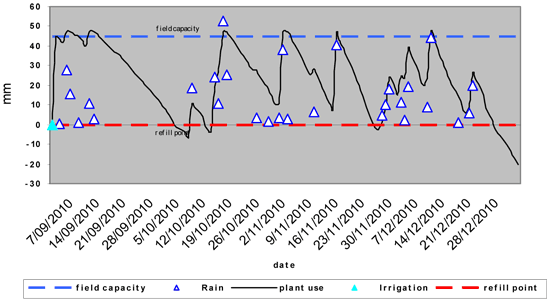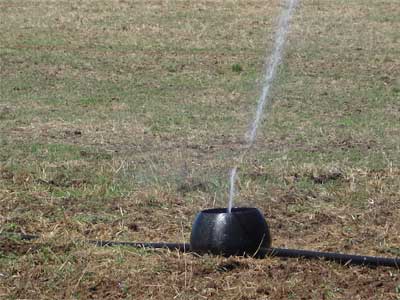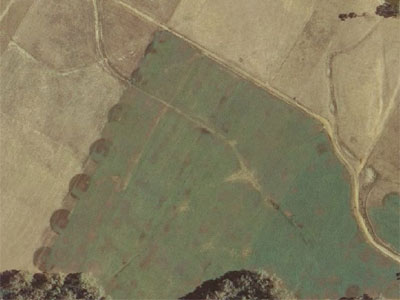IrriGate newsletter, Issue 5 summer 2011
Download the PDF version of this document: Irrigate Newsletter - Issue 5 - Summer 2011 (PDF 270 KB)
To view the information PDF requires the use of a PDF reader. This can be installed for free from the Adobe website (external link).
Sustainable Irrigated Landscapes - North East - Mid and Upper Goulburn Broken
 |  |
| North East Dryland Catchment | Goulburn Broken Dryland Catchment (excluding the Shepparton Irrigation Region) |
Welcome to IrriGate Issue 5
This is an interesting irrigation season we are having. Sometimes I wonder if it’s easier to manage irrigation in a dry season, when we know it is going to stay dry.
Editor - Wendy Paglia
Rainfall keeps lucerne happy till Christmas | GPS tool to help correct sprinkler placement | Funding for irrigation upgrades
Rainfall keeps lucerne happy till Christmas
Some irrigators across the region are monitoring and comparing water applied via irrigation and rainfall to theoretical crop water use. Rainfall on a Rutherglen lucerne crop has been enough to supply sufficient water to meet its needs up till Christmas. There were a few times where irrigation was required but opportune rainfall fell soon after.
The graph in Figure 1 shows the profile drying out from mid September and going past the refill point (red line) just before an 18 mm rainfall event. Up until Christmas, apart from a few dry periods the rainfall did pretty well to keep up with plant demands, obviously providing a little too much water at times. Irrigation between Christmas and the new year should have been applied.

Figure 1: Soil water budget of a lucerne crop in Rutherglen
GPS tool to help correct sprinkler placement
| Correct paddock placement of bike-shift and K-line sprinklers (Figure 2) is crucial for efficient irrigation. Incorrect placement can lead to low distribution uniformities (a measure of how even water is applied) which means either pasture production is not maximised or more water has to be applied and pumping energy used to ensure dry spots are not occurring. The distribution uniformity can vary from 70 to 85 per cent depending on sprinkler placement. A monitor mounted on an ATV is now available using GPS to show correct placement. The device has been developed by a New Zealand company called Tracmap (www.tracmap.co.nz - external link). |  Figure 2: K-line sprinkler |
| A common issue among bike shift and K-line irrigators is a reluctance to let anyone else do the shifting to avoid pasture production losses as in Figure 3. This system should increase confidence to allow other people to move the sprinklers. Normally costing around $6,000 a grant is available to reduce this cost to $3,000. If anyone is interested in more information please contact Dennis Watson. If there is enough interest, some demonstration days will be organised. |  Figure 3: Aerial photograph showing dry patches due to incorrect sprinkler placement. |
Funding for irrigation upgrades
The Australian Government On-Farm Irrigation Efficiency Program Round 2 is likely to be launched in March 2011 with an open call for Expressions of Intent to improve farm irrigation system performance and efficiency. The Goulburn Broken Catchment Management Authority and consortium members will be making a submission to the Australian Government On-Farm Irrigation Efficiency Program and hopefully we will see conversion to spray and drip irrigation funded as part of a suite of eligible water saving technologies.
Conditions will apply and are likely to be:
|  Figure 4: It is hopeful the Farm water round two will include conversion to spray and drip irrigation. |
DPI NE/GB Sustainable Irrigation Team - Dryland
| Dennis Watson Irrigation specialist DPI Rutherglen Centre (02) 6030 4567 0429 304 567 dennis.watson@dpi.vic.gov.au |  Dennis Watson |
| Ian Gamble Catchment Management Officer DPI Wangaratta Centre (03) 5723 8671 0437 362 620 ian.gamble@dpi.vic.gov.au |  Ian Gamble |
| Wendy Paglia Project Support Officer DPI Ovens Centre (03) 5731 1206 wendy.paglia@dpi.vic.gov.au |  Wendy Paglia |
If you would like to receive this information/publication in an accessible format (such as large print or audio) please call the Customer Service Centre on: 136 186, TTY: 1800 122 969, or email customer.service@dpi.vic.gov.au
Published by the Department of Primary Industries, Sustainable Irrigated Landscapes, March 2011,
© The State of Victoria, 2011
This publication is copyright. No part may be reproduced by any process except in accordance with the provisions of the Copyright Act 1968.
Authorised by the Victorian Government, 1 Spring Street, Melbourne 3000
ISSN :1837-4077
Disclaimer:
This publication may be of assistance to you but the State of Victoria and its employees do not guarantee that the publication is without flaw of any kind or is wholly appropriate for your particular purposes and therefore disclaims all liability for any error, loss or other consequence which may arise from you relying on any information in this publication.
For more information about DPI go to www.dpi.vic.gov.au or call the Customer Call Centre on 136 186.


